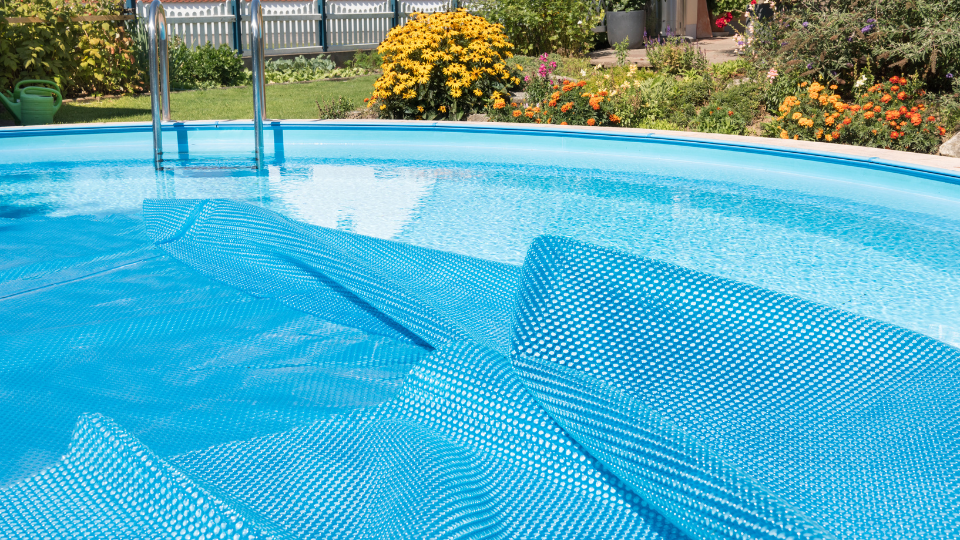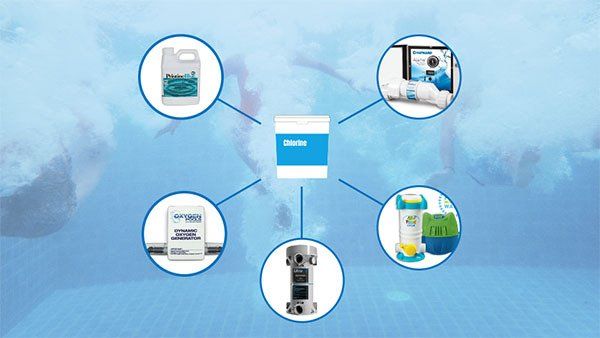Can a Pool Be Eco-friendly? 6 Tips for a More Sustainable Swimming Pool
Have you ever heard of a green swimming pool?
Probably, right?
But we don’t mean the green algae kind of pool.
We mean the kind of pool that is eco-friendly and energy efficient. Ever heard of one of those?
No? Maybe?
Well, let’s talk about those quickly. An eco-friendly pool, also called natural swimming pool is a one hundred percent chemical free ecosystem made up of plants that help keep the water clean.
While a chemical free pool is a wonderful concept, we are not here to learn about those. Regular swimming pools need sanitization and can never be one hundred percent eco-friendly. BUT we are here to show you how you can make your regular pool more sustainable, using less chlorine, while saving some money down the road.
Let’s dive in.
What is Chlorine and Why Are People Looking For Alternatives
Chlorine is the most widely used sanitizer in the pool industry. It comes in different forms, liquid, tablets, granules, and powder. The Environmental Protection Agency has recognized it as a primary sanitizer because it is the most reliable method for killing bacteria. In small amounts, chlorine is safe and commonly used in water purification.
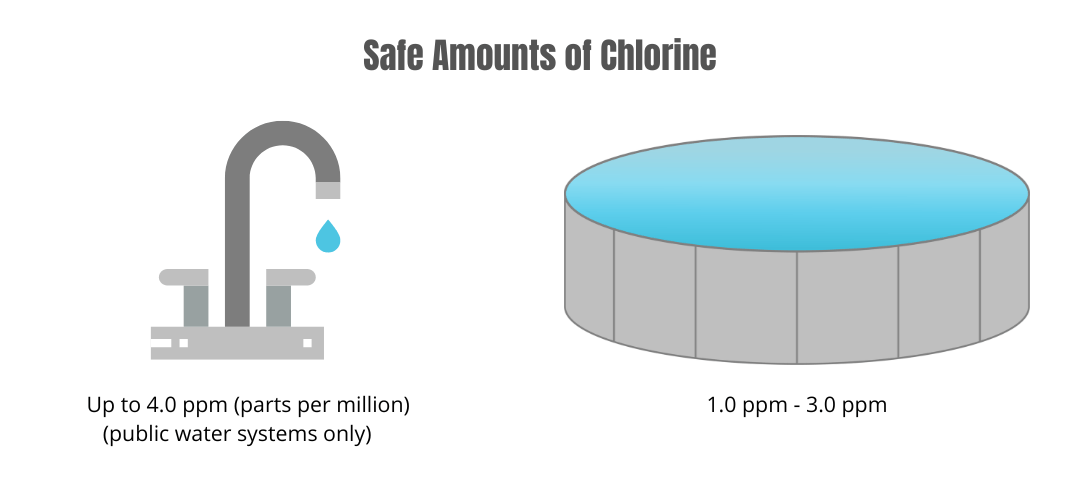
So, as you can see the amount of chlorine in your pool is actually less than the allowance for drinking water.
Now you probably wonder, so what’s the problem?
Although Chlorine is an essential component that keeps people safe, there are a variety of reasons why people want to switch to alternative sanitizing methods. Let’s take a closer look at some of the problems that can be associated with chlorine.
Chlorine Odor
People often complain about that strong chlorine smell coming from their pool. Thinking that there is too much chlorine in the water because of the odor is actually one of the biggest misconceptions about swimming pools.
Chlorine odor is actually a byproduct of another chemical called chloramines. Chloramines are formed when free chlorine binds to body waste (sweat, urine, etc.). This process is referred to as off-gassing which occurs when the pool water is not properly balanced.
This is why swimming pools always ask you to shower and wash off body oil before going swimming.
Chlorine Off-Gassing
Chlorine off gassing goes hand in hand with chlorine odor. The biggest concern surrounding chlorine are the potential health risks associated with the chemical gas.
As mentioned above the toxic vapors released can stem from the formation of chloramines. This can be particularly dangerous in indoor swimming pools without proper ventilation.
Off-gassing also occurs if chlorine isn’t stored or handled properly. You should never mix chlorine with other chemicals and always follow the manufacturer's instructions.
Residual Chlorine and Skin Irritation
Chloramines are also the reason a strong chlorine smell remains on your body and hair after getting out of the pool. Swimmers call this residual chlorine.
It is the chloramine that bonds with your body’s protein causing discoloration of the hair, as well as skin drying and irritation. The best way to minimize side effects is by limiting the exposure to chlorine and showering immediately after swimming.
It's Easy to Over Chlorinate
If you don’t really know what you are doing it is very easy to think you can just add a bunch of chlorine and your pool will be sanitized. Adding too much chlorine is very easy and as we learned above can have adverse effects on our skin, hair, and respiratory system.
For people who don’t want to run into the risk of over chlorinating, an alternative system might be a better solution.
Sunlight Breaks Down Chlorine
If you have been a pool owner for some time you are probably familiar with the fact that ultraviolet light breaks down chlorine in the pool.
This means you need to take some additional steps to slow down that process - such steps include using a stabilizer like cyanuric acid to keep chlorine in the pool longer, a solar cover to protect chlorine from the sun and evaporation, and only shocking the pool at night so it sanitizes before the sun can break it down.
These processes are known as
managing chlorine demand. They add some additional care requirements to lower maintenance expenses.
Chlorine Shortage
Ever thought that a chlorine shortage could be a possibility? Well, we just learned that it can be due to a combination of factors.
Covid19 forced people to stay home and cancel their vacations causing
new pool constructions to go up by 25 percent and with it the demand for chlorine.
At the same time a major chemical plant in Louisiana that made up a large percentage of the chlorine production in the USA burned down.
The chlorine shortage has been an ongoing challenge for pool companies as well as pool owners and a major reason for using alternative sanitizing systems.
Now you know more about chlorine and the problems associated with it. Although we can’t help you get a one hundred percent eco-friendly above ground pool, let's talk about some chlorine alternatives for pools. All of them can help lower the demand and save you some money down the road.
1. Alternative Pool Systems
Over the past couple of years people have been looking for different ways to lower their chlorine consumption. The chlorine shortage in 2021 has left pool owners struggling to sanitize their pools and it looks like this shortage will continue throughout the 2022 season.
Others may want to switch simply because they don’t like chlorine or they are trying to lower their maintenance cost. Whether you have a new pool or an existing one it is not too late to make the switch. Here are several different pool systems that either help achieve a chlorine free pool or at least reduce the demand significantly.
Copper System
Copper-based pool systems such as Pristine Blue is one of many alternative ways to keep your water clean. Unlike a salt chlorinator, ozonator or UV sterilizer, it does not include any costly hardware that needs to be installed.
Instead of using chlorine as the sanitizer you can use chlorine free shock to make your pool chlorine free.
Salt Chlorinator
Saltwater pools are the second most common method of pool sanitation. Salt generators work by using electrical currents to convert salt to chlorine. This eliminates the need for chlorine during a chlorine shortage.
Salt water pools require less maintenance and are less harsh on the skin. While a salt pool is more expensive initially, it can save money in the long run.
Ozone and UV Systems
Ozone and UV Systems are secondary disinfection systems that are still relatively new to the industry when compared to chlorine and salt pools. Together they eliminate chlorine-resistant microorganisms at a kill rate of 99.9 percent reducing chlorine levels by 50 to 90 percent, making them popular chlorine alternatives for pools.
Both units have been EPA approved as sanitization methods and are environmentally friendly. As a standalone system, ozonators still work by killing off bacteria but it needs another chemical to break down the dead bacteria.
Mineral Systems
Like Ozonators and UV sterilizers, Mineral Systems act as a secondary disinfection system to help reduce chlorine consumption in your pool or spa. Copper and Silver are used to combat both algae and bacterial growth. Combatting bacteria completely requires either some chlorine or some chlorine free shock.
Can You Save Money Switching to an Alternative System
Swimming pool maintenance can get expensive, especially if you don’t keep up with it and constantly have to power shock your pool. Sometimes it is easier to switch to a greener pool system that not only saves you money but reduces the time spent on maintenance.
Here is a chart comparing the alternative pool systems we introduced above. Keep in mind that this chart is based on a 4 months swimming season.
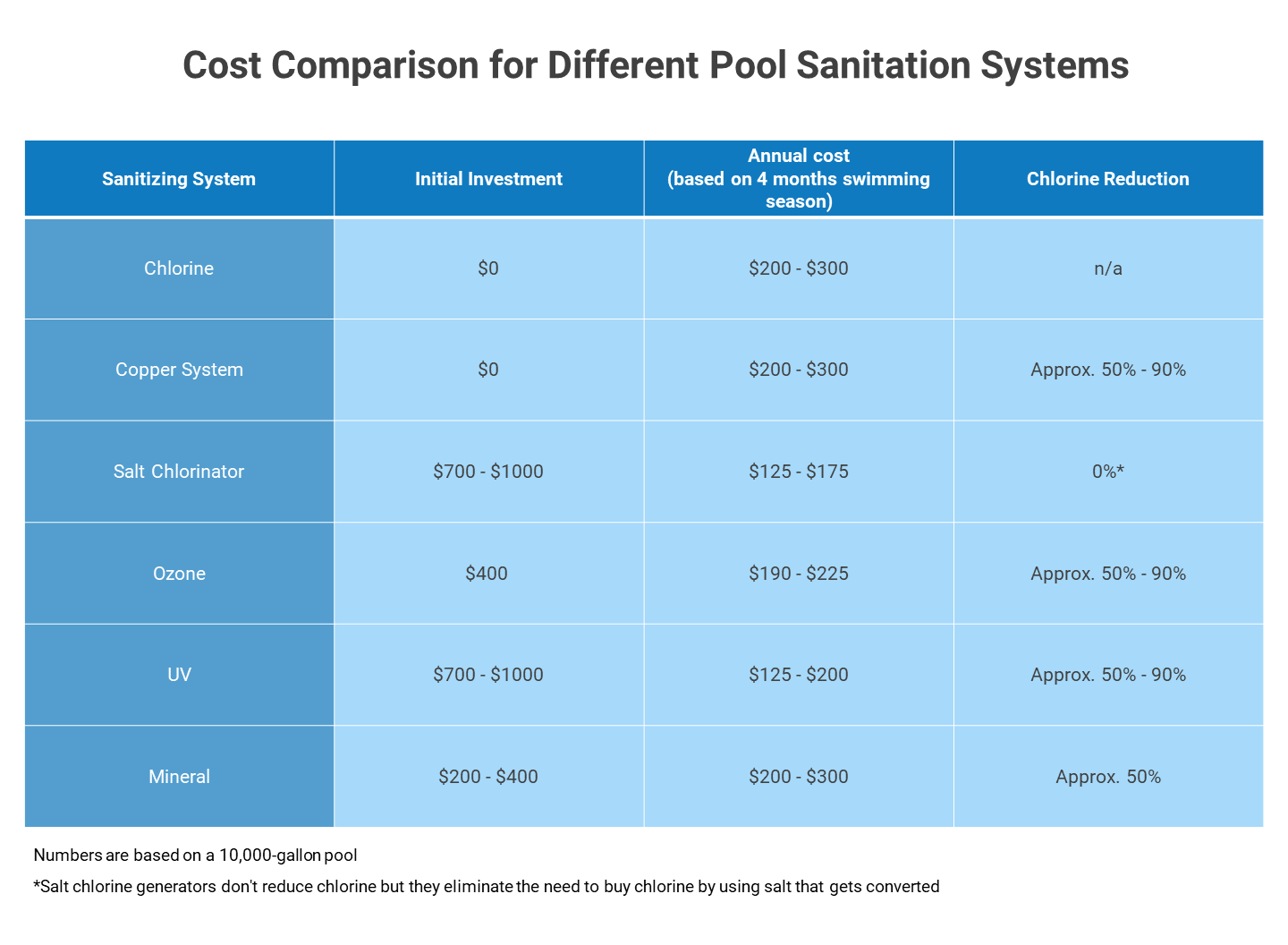
Switching to an alternative pool system is only one step towards a more eco-friendly above ground pool. If you want to save time and money long term you might want to think about all other aspects affecting your pool.
Energy-saving equipment and overall sustainable pool maintenance can all have an impact on the cost and efficiency of your pool.
2. Energy Efficient Pool Equipment
We just explored some great alternative pool systems that help reduce or eliminate the need for Chlorine. Now let’s take a look at what you can do to make your newly converted pool even “greener” by using energy-efficient pool equipment.
Pool Pumps
Pool pumps are considered the heart of your pool’s circulation system and one of the biggest energy users in your home. In fact, they can use three times more electricity than your refrigerator. There are three types of pumps, single-speed, dual-speed, and variable-speed pumps.
Single-Speed Pumps
Single-speed pumps as the name suggests operate at a single RPM and make up the majority of pool pumps in the U.S. They are the cheapest initial investment compared to the other two types of pumps. However, they are the least energy-efficient units, therefore costing you more year after year.
Dual-Speed Pumps
Dual-Speed Pumps, also called two-speed pumps use an induction motor and offer more flexibility as they can operate at two different RPM’s, typically 3,450 rpm (full speed) or 1,725 RPM (half speed) also reducing energy consumption.
Variable Speed Pumps
Variable-Speed Pumps are the top energy saver for your pool with an energy efficiency of 90 percent. These energy efficient pool pumps offer a lot more flexibility because you have complete control over the speed ranging from 600 rpm to 3,450 rpm.
Although Variable-Speed Pumps are more expensive initially you will end up saving more money over time.
Energy Star Certified Pool Pumps
With all three pool pumps in mind not all pumps are created equal. Some pumps are individually certified by the Department of Energy to be more energy efficient.
Energy Star Certified pool pumps run quieter and prolong the life of your pool’s filtration system and save you more money over its lifetime.
Many utility companies offer rebate programs for Energy Star certified pool pumps. Please contact your local pool store or utility company or visit the
Energy Star website.
Pool Filters
If pool pumps are the heart of your system, pool filters are considered the kidney. They help filter out all the impurities in the water, such as debris, bacteria, and algae. Without a filter swimming pool water would not be able to remain clear.
Just as with pool pumps there are three different types of pool filters. Let’s take a look at them, how they work, and which one is the most eco-friendly pool filter.
Sand Filter
Sand filters as the name suggests is a unit that is filled with a special sand mixture that is designed to catch small particles the size of 20 microns. They are relatively inexpensive and low maintenance. Instead of dismantling the unit to clean the filter you do a simple backwash and the dirt gets pushed out.
D.E. Filters
D.E. Filters use a cartridge unit that gets coated with Diatomaceous Earth (D.E.), which are fossilized remains of tiny aquatic organisms. This pool filter is best for filtering out the smallest particles (2-5 microns). You can get D.E. filters either with a backwash function or without it. If you get it without it you need to take the filter apart for cleaning.
Cartridge Filters
Cartridge filters are a little more work because you have to remove the filter and hose it down. However, they are the greenest of the three filters because they don’t require backwashing in which you lose gallons of water and chemicals. Cartridge pool filters also filter out debris as small as 10 microns, smaller than sand filters.
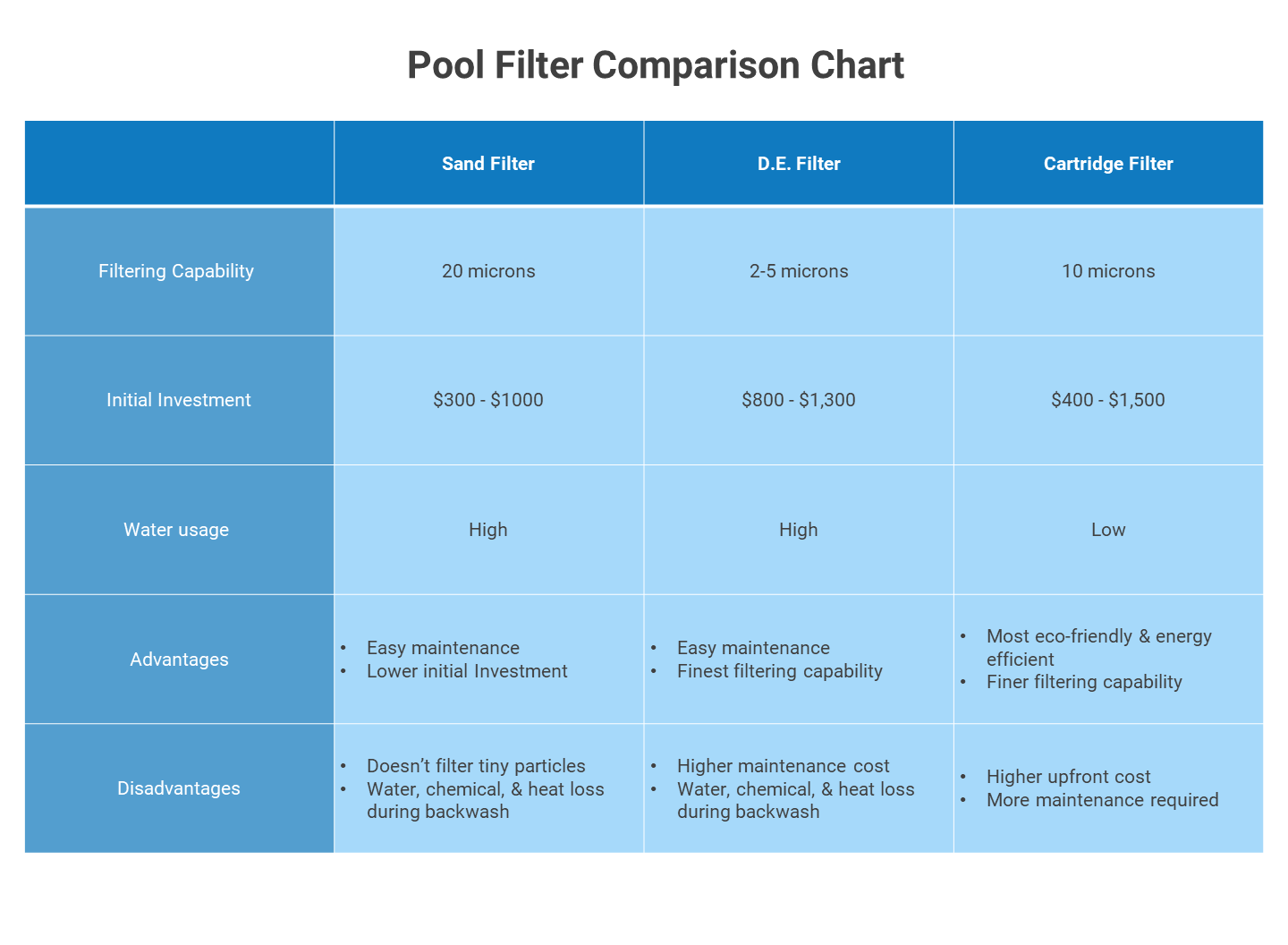
The best pool filter is the one that fits best into your budget and maintenance requirements. If you want a filter that is most efficient and more environmentally friendly though, the cartridge filter will be the best choice.
Pool Heaters
Gas Heater
Natural gas and propane heaters are both considered green energy sources. However, there are some differences between the two.
For one, natural gas releases less carbon dioxide than propane, helping to reduce the amount of greenhouse gasses produced. It is also a much less expensive gas.
Propane on the other hand produces more energy per cubic foot and uses less fuel making it more energy efficient.
Whichever gas heater you choose, consider the amount of BTUs the heater produces. If you have a large pool you don’t want to buy a small heater to save money initially just to have to increase the amount of BTUs to heat the pool.
Solar Heater
Similar to solar panels solar heaters use the sun as its energy source to heat the water. There are different types of heaters, some are long panels leaning against a frame or your pool while others are small hoses curling through a dome like feature.
You do need to run the pool pump to push the water through the solar heater but it requires much less energy than a conventional pool heater.
Heat Pump
Heat pumps work similarly to a solar heater but instead of using the sun the heater uses the warm air. A fan pulls in the warm air from the atmosphere and transfers it through a multistep process into the cold water, warming it and returning it back into the pool.
The downside of a heat pump is that it requires a minimum of 45 to 50 degrees Fahrenheit to run efficiently. This makes the heater less ideal for cooler climate regions.
Comparing the three heaters side by side all of them are considered energy efficient. Choosing one should be based on the climate you live in, your budget, the size of your pool, and the gas prices.
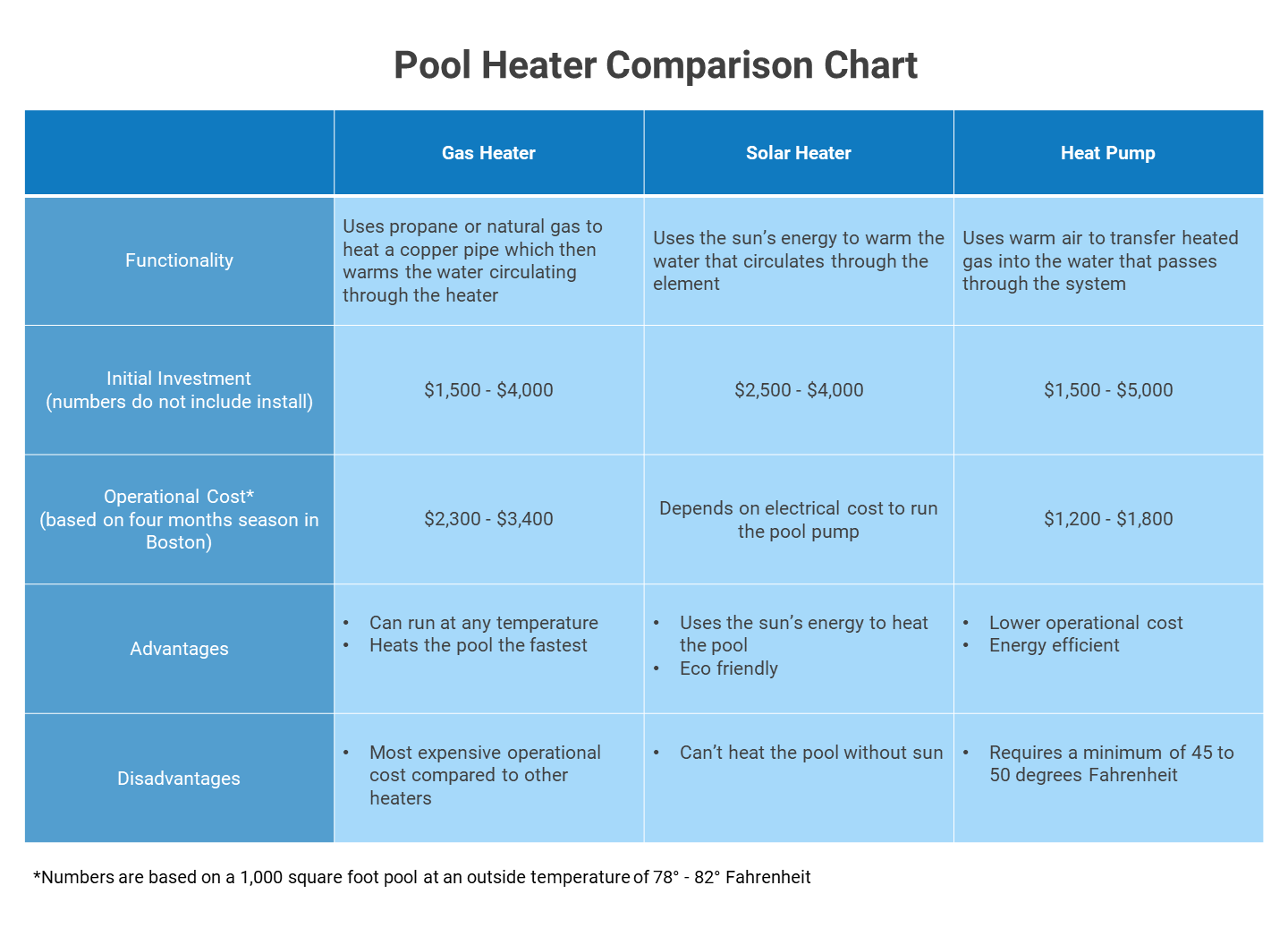
Other Ways to Manage Your Heating Cost
Pool Cover
If you have an inground pool consider investing in an electric pool cover, it will help preserve the heat and prevent water evaporation. It also helps to keep debris out of your pool.
Solar Cover
A solar cover can not only preserve the heat but make your pool warmer as the sun’s energy is captured through the cover and transferred into the pool water. This can also prevent some debris from falling in and sinking to the bottom of your pool.
Liquid Blanket
A liquid blanket or liquid cover essentially works the same way as a solar cover. It typically contains a mixture of alcohol and calcium hydroxide that forms a film on top of your pool water. It is completely safe for swimming.
3. Sustainable Pool Maintenance
Energy-efficient pool equipment can be a huge relief to your wallet but it doesn’t end there. There is more you can do to run your pool as efficiently as possible with sustainable pool maintenance.
Properly Balanced Pool Water
A properly balanced pool will save you a lot of money in chemicals. We often see pool owners sporadically add chemicals to their pool as they see fit. Two things happen with this process.
One, if the pool is not properly balanced it can be harmful to the swimmer as bacteria has the opportunity to grow.
Two, every time you let your pool go you have to add more chemicals. We recommend testing your water regularly and bringing water samples to your local pool store if you have trouble controlling ranges.
Order and Timing of Pool Chemicals Are Important
Another factor is the time chemicals are added. UV rays can burn off chlorine. Therefore it is best to add it at night time. Other chemicals have to be added in a certain order for them to work their magic. If you are unsure about how to properly balance your pool water ask your local pool professional for guidance.
Pool Pump Run Time
Your pool pump is the biggest energy consumer as we previously discovered but you have to run your pump in order for the water to circulate and keep it clean.
So what is the most efficient run time?
It depends!
How long and when you should run your pump varies based on your water volume (how many gallons of pool water), the pump itself, and the climate you live in.
On average a pool pump should be running 8 hours a day. If you have a small pool with an oversized pump you might be able to reduce pump running time by 2 hours. Alternatively if you have a dual speed or variable-speed pump you can reduce the horse power to make it run more efficiently.
Water Evaporation And Heat Loss
Both phenomena occur in pool water at any given time, which can add to your energy consumption. When water evaporates you have to top it off with new water as well as chemicals. Running a heater for hours is not an optimal solution especially for your wallet. Solar blankets or covers are a great way to keep the heat in the water and prevent it from evaporating.
Regularly Check for Leaks
Always keep an eye on your water level to ensure there are no leaks. While losing water can also be due to evaporation you want to make sure you don’t have any holes in your liner that’s causing the dropdown.
Having to add water to your pool can drastically impact your water, electric and chemical bill as adding new water will impact your water balance and cool your heated water.
4. How to Run Your Pool More Efficiently with an Automation Systems
Do you currently control all your pool equipment manually? Rapid technological industry advancements make it easier to spend less time on maintenance and more time relaxing.
With pool automation you can control things like your pool pump, heater, and lights as well as monitor your pool chemistry.
Robotic Cleaners
Another technology that is cost effective are robotic cleaners. They can save energy because you don’t have to use the pump and filter to run them like other manual pool vacuums.
Some of the new robotic cleaners climb the pool walls, and skim the top while being controlled from a cell phone app. These gadgets not only save you energy but also time so you can spend more of it relaxing.
5. Landscape and Location
Did you know that landscaping and the location of your pool can increase your energy and maintenance costs? Think about those leaves, pine needles, and other debris you are constantly cleaning out of your pool.
If you are thinking about putting a pool into your backyard consider a spot that is not surrounded by trees. Many pool owners like to create a physical barrier around their pool to prevent neighbors from peeking in. Those can actually serve well as a wind barrier too.
6. Hire A Professional Pool Company
There is nothing worse than trying to figure out how to clean and clear your pool if you cannot figure out what’s wrong. Sometimes it’s as simple as adding shock and taking a water sample to your local pool store.
Other times nothing you seem to try is working and you spend all your energy, time and money trying to fix it. A professional pool company will be able to identify the problem quickly and can save you a lot of headaches and potentially money.
Family Pools North is always happy to help,
contact us or visit our store at 3 Newton Junction Road in Kingston, NH.


